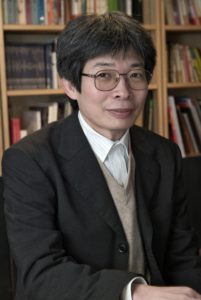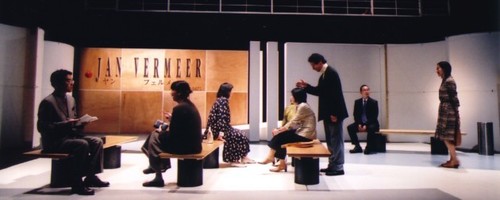“Tokyo Notes” is Hirata’s awarded piece at the 39th Kishida Kunio Drama Award, the most important and prestigious award for Japanese playwrights, in 1995. The piece has been translated into 7 languages including Chinese, English, French, German, Italian, Korean and Thai, and has been performed in 12 cities in 9 countries.
Hirata proposed the “contemporary colloquial theatre theory”, has drawn much attention in the 1990s and has had a great influence on the Japanese theater. This theatre theory practice in Hirata’s work, which the actors sometimes speak with their backs to the audience and several people talk at the same time so that conversations overlap just as often happens in real life, and he never uses any music to heighten theatrical effects. According to Hirata he, “rejects advocating any theatrical ‘ism’ and aims for a theatre that is a direct portrayal of the world.”
Now this internationally acclaimed piece will tour Bangkok and Jakarta as well as Kuala Lumpur in June and July.
“Tokyo Notes” (with English and Malay subtitles):
Date & Time:
29 (Thu) June 2006 – 1 (Sat) July 2006 @ 8:30pm
2 (Sun) July 2006 @ 3pm
Venue:
Pentas 2, Kuala Lumpur Performing Arts Centre (KLPac)
Sentul Park, Jalan Strachan, off Jalan Ipoh
Ticket:
RM30, RM15 (Students, Senior Citizens & JFKL members)
available at: KLPac box office 03-4047 9000
The Actors Studio Bangsar box office 03-2094 9400
For further enquiry, please contact:
The Japan Foundation, Kuala Lumpur
Tel: 03-2161 2104
Email: jpcc@jfkl.org.my
Click here to view the schedule of Playwright workshop by Oriza Hirata.
Tokyo Notes
About the Piece
Premiered in 1994, “Tokyo Notes,” one of the most renowned works of Oriza Hirata and Seinendan, depicts the gradual dissolution of family and human relations in the modern society and is highly acclaimed both in Japan and abroad.
In 1995 Hirata won the 39th Kishida Kunio Drama Award with this piece and Seinendan has been presenting “Tokyo Notes” in various theaters and art museums in Japan and in 12 cities in 9 other countries. It has been translated into 7 languages so far.Non-Seinendan presentations include a 2-month tour production in France by a cast of French actors directed jointly by Frederic Fisbach and Oriza Hirata, which came about as the result of a well-received drama reading of the play in a 1998 FIFA World Cup-related event when it was selected as the contemporary drama to represent Japan. In 2003, a Koreantheater company did a long run of “Seoul Notes,” an adaptation, in Seoul. “Seoul Notes” was presented again successfully in 2004 as a Japan-Korea collaboration.
Synopsis
The story takes place in the lobby of an art museum in the near future.
A major war is being waged in Europe. In front of the paintings evacuated from the war-torn areas, the visiting Japanese family members, friends and lovers endlessly continue fragmentary conversations about taking care of ageing parents, their future careers, love, inheritance and whatnot.
Against the huge backdrop of war, it scrupulously portrays the Japanese people living their ordinary everyday lives, revealing a whole range of problems and crises of the modern society.
On “Tokyo Notes”
As its title implies, I got an idea for “Tokyo Notes” from Yasujiro Ozu’s (小津安二郎) masterpiece “Tokyo Monogatari / 東京物語 (Tokyo Story).” Where in Ozu’s film the old parents visiting their children in Tokyo are delineated scene after scene, “Tokyo Notes” depicts the siblings, now living separately in Tokyo, gathering in the lobby of an art museum in Tokyo when their art-loving sister living in their hometown comes to visit. Naturally, each of them has his/her own life and pains but now their only common interest is who takes care of the parents. As another background, it is suggested that a major war is going on far away in Europe. But the people gathered here look so unrelated to the great global shift, concerned only about their own lives and problems.
If theater is a device to depict the vibrations of human minds, this piece may have been an attempt to reveal the minutest of such vibrations. I hope to present to the audience what vibrates quietly in the double chaos of the enormous conflict between nations and that in a family, the smallest unit of people.in the 90’s.
Seinendan青年団
Seinendan (direct translated as Youth Group) was founded in 1983. It has been a most up-front theater company with the Komaba Agora Theater as its home base. The actors never stopped evolving. The “contemporary colloquial theater theory” proposed by Oriza Hirata (artistic director and playwright) and the innovative theatrical style Seinendan has developed to put the theory into practice and it has drawn much attention in 1990s. They have great influences on the younger generation of the theater community.
Hirata claims that modern theater in Japan which started out by importing the Western modern theater has also lead to playwriting governed by the Western logic. Thus, he believes, writing styles and logical structures irrelevant to the Japanese language have been routinely practiced, and in trying to give those irrelevant styles reality the actors have been forced into distorted acting styles too. This is the heart of Hirata’s criticism of the conventional Japanese theater.
Instead of ostentatious ideas and tricks, Seinendan chooses a clear and firm theory to create the productions in order to establish a new expression that can alter the framework of theater itself.
Contemporary Colloquial Theatre 現代口語演劇
Hirata’s “contemporary colloquial theater” has drawn much attention in the 1990s and has had a great influence on the Japanese theater. Our daily life is not a continuous string of grande passions and murders — big events conventional theater has eagerly portrayed. Instead, the main portion of life is filled with quiet and uneventful times. Hirata often uses such quiet times for his theatrical works. The existence of people is essentially amazing and dramatic. Life itself is merry, graceful, funny, stupid, complicated and fertile by nature. The actors try to abstract and then reconstruct the diverse elements and present the quiet life directly on stage.
Seinendan URL: http://www.seinendan.org
Oriza Hirata平田オリザ
 He is playwright, director, leader of Seinendan, and artistic director of Komaba Agora Theater. Born in Tokyo in 1962. Graduated from International Christian University, College of Liberal Arts, Humanities Division.
He is playwright, director, leader of Seinendan, and artistic director of Komaba Agora Theater. Born in Tokyo in 1962. Graduated from International Christian University, College of Liberal Arts, Humanities Division.
In 1995, he won the 39th Kishida Kunio Drama Award with “Tokyo Note (Tokyo Notes)”. In 1998, he received the 5th Yomiuri Theater Award Outstanding Director Award, for his production of “Tsuki no Misaki (The Cape of the Moon)”, a play written by Masataka Matsuda.
Hirata wrote and directed “Ueno Dobutsuen Sai-sai-sai Shugeki (Attacking Ueno Zoo for the Fourth Time)” in 2002 and won the Yomiuri Theater Award for Outstanding Production. In 2002, he won AICT (Association Internationale des Critiques des Theatre) Critique Award for his book “Geijutu Rikkokuron (Arts as the Basis of a Nation)” published from Shueisha.
In 2003, he won the Grand Prix of the 2nd Asahi Performing Arts Awards with “Sono Kawa wo Koete, Gogatsu (Across the River in May)”, which was an event for the Year of Japan-ROK (Republic of Korea) National Exchange in 2002.
At present, he is Professor of Osaka University Centre for the study of Communication-Design, artistic director of Fujimi Culture Hall KIRARI FUJIMI. He is also Japanese Textbooks Editorial Board member of Sanseido Publishing Company, board member of the Japan Foundation for Regional Art-Activities, the Japan Performing Arts Foundation, the Japanese Society for Theatre research, and the Japan-Korea Arts Exchange advisor for the Agency for Cultural Affairs.
Oriza Hirata is one of the key figures in the contemporary theater scene in Japan.
His thinking and direction
Quoted from ‘Half a Century of Japanese Theatre’, by Senda Akihiko
Beginning with the performance of City of Light (Hikari no miyako) in 1988, Hirata began directing all his own plays. At the same time came the birth of the characteristic Seinendan performance style.
In Tokyo of the 1980s, troupes headed by Hideki Noda (now leader of NODA MAP) and Shoji Kokami, were riding a wave of popularity among young audiences with a richly frenetic, highly paced style of performance. The main impression of their pieces was one of exaggerated comical presentation. This reflected Japan’s strong economic vigor in what is known as the “bubble economy” of the 1980s.
Hirata moved against that tide and strove to regain a feeling of theatrical realism both performatively and directorially. He was attempting to achieve thoroughness in performance that went beyond so-called realism. The actors of the Seinendan reject any stagey vocal method actions and at times speak in such a natural and off-hand manner that their voice is too low for the audience to hear. The actors sometimes speak with their backs to the audience and several people talk at the same time so that conversations overlap just as often happens in real life. Furthermore, in his staging Hirata never uses any music to heighten theatrical effects.
In his direction, Hirata takes great care to exclude his own opinions and subjectivity. According to Hirata he, “rejects advocating any theatrical ‘ism’ and aims for a theatre that is a direct portrayal of the world.” In his theatrical world things are not spoken of frankly, but he says, “statements take an indirect form as often as possible.”
Therefore, in Hirata’s plays, even if an actor is sad in a certain scene, “sadness” is not expressed directly. Hirata says that, ‘the relative sadness of something is quite vague and cannot be expressed by the actor.” Displays of emotion are avoided, and what foreigners sometimes see as inexpressive Japanese behavior, is included in a minutely realistic acting method.
… The term “quite theatre” came into popular use among journalists in Japan in the 1990s. This was theatre which was a reaction to the frenetic style that had gained so much popularity during the 1980s. The term was used to refer to playwrights such as Oriza Hirata, Ryo Iwamatsu and Akio Miyazawa. Hirata can be seen as the most representative of that group.



